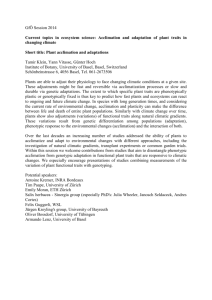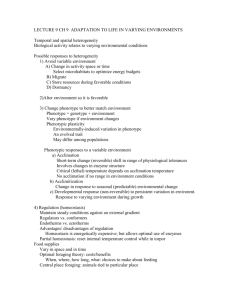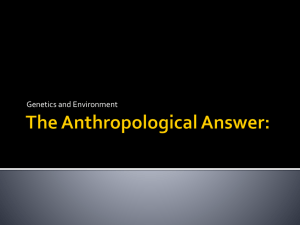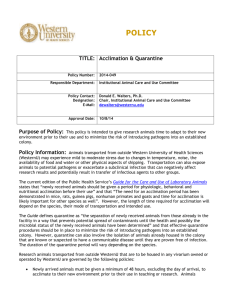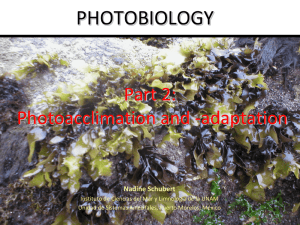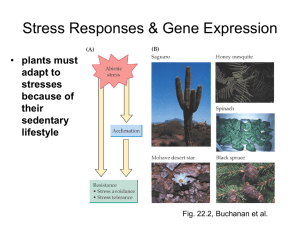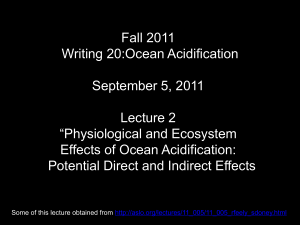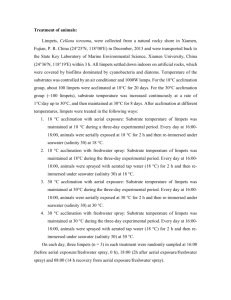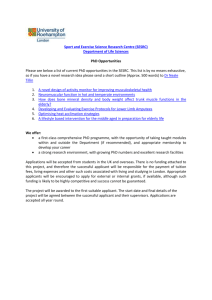Little Effect of Training in the Heat on Cycling
advertisement
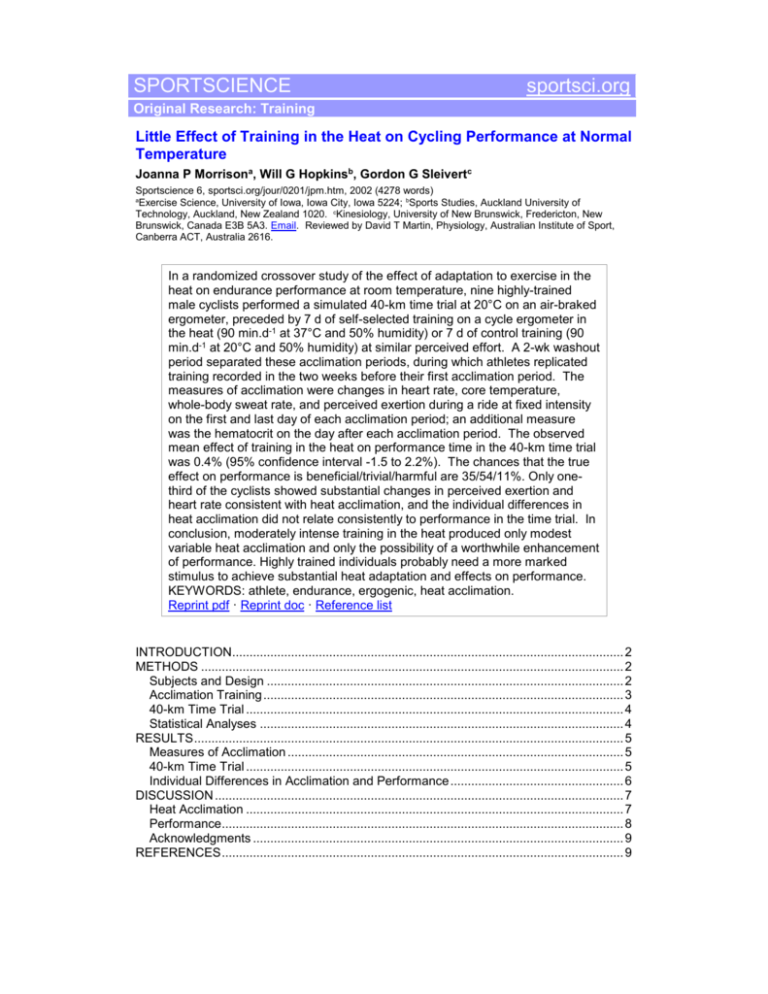
SPORTSCIENCE sportsci.org Original Research: Training Little Effect of Training in the Heat on Cycling Performance at Normal Temperature Joanna P Morrisona, Will G Hopkinsb, Gordon G Sleivertc Sportscience 6, sportsci.org/jour/0201/jpm.htm, 2002 (4278 words) a Exercise Science, University of Iowa, Iowa City, Iowa 5224; bSports Studies, Auckland University of Technology, Auckland, New Zealand 1020. cKinesiology, University of New Brunswick, Fredericton, New Brunswick, Canada E3B 5A3. Email. Reviewed by David T Martin, Physiology, Australian Institute of Sport, Canberra ACT, Australia 2616. In a randomized crossover study of the effect of adaptation to exercise in the heat on endurance performance at room temperature, nine highly-trained male cyclists performed a simulated 40-km time trial at 20°C on an air-braked ergometer, preceded by 7 d of self-selected training on a cycle ergometer in the heat (90 min.d-1 at 37°C and 50% humidity) or 7 d of control training (90 min.d-1 at 20°C and 50% humidity) at similar perceived effort. A 2-wk washout period separated these acclimation periods, during which athletes replicated training recorded in the two weeks before their first acclimation period. The measures of acclimation were changes in heart rate, core temperature, whole-body sweat rate, and perceived exertion during a ride at fixed intensity on the first and last day of each acclimation period; an additional measure was the hematocrit on the day after each acclimation period. The observed mean effect of training in the heat on performance time in the 40-km time trial was 0.4% (95% confidence interval -1.5 to 2.2%). The chances that the true effect on performance is beneficial/trivial/harmful are 35/54/11%. Only onethird of the cyclists showed substantial changes in perceived exertion and heart rate consistent with heat acclimation, and the individual differences in heat acclimation did not relate consistently to performance in the time trial. In conclusion, moderately intense training in the heat produced only modest variable heat acclimation and only the possibility of a worthwhile enhancement of performance. Highly trained individuals probably need a more marked stimulus to achieve substantial heat adaptation and effects on performance. KEYWORDS: athlete, endurance, ergogenic, heat acclimation. Reprint pdf · Reprint doc · Reference list INTRODUCTION................................................................................................................. 2 METHODS .......................................................................................................................... 2 Subjects and Design ....................................................................................................... 2 Acclimation Training ........................................................................................................ 3 40-km Time Trial ............................................................................................................. 4 Statistical Analyses ......................................................................................................... 4 RESULTS ............................................................................................................................ 5 Measures of Acclimation ................................................................................................. 5 40-km Time Trial ............................................................................................................. 5 Individual Differences in Acclimation and Performance .................................................. 6 DISCUSSION ...................................................................................................................... 7 Heat Acclimation ............................................................................................................. 7 Performance.................................................................................................................... 8 Acknowledgments ........................................................................................................... 9 REFERENCES .................................................................................................................... 9 INTRODUCTION Training in the heat provides an opportunity to adapt to increased environmental temperature before performing in a thermally stressful environment. After heat acclimation athletes have a lower core temperature at rest (Buono et al., 1998) and during exercise in the heat (Sawka et al., 1983; Armstrong and Kenney, 1993). An increase in sweat rate (Nadel et al., 1974), a decrease in sodium content of sweat (Kirby and Convertino, 1986), a redistribution of sweating (Kirby and Convertino, 1986), and a lowering of the threshold temperature for initiating the sweating response (Williams et al., 1967) have also been observed after heat acclimation. There is also an expansion of plasma volume (Senay et al., 1976; Kirby and Convertino, 1986), which allows for increased blood flow to the skin to dissipate heat without seriously compromising blood flow to muscles. Some of these adaptations probably account for the enhancement of physical performance in the heat that occurs with heat acclimation (Young et al., 1985; Kirwan et al., 1987; Armstrong and Maresh, 1991). Whether these adaptations enhance performance at normal temperature is unknown. The purpose of this study was therefore to determine if adaptations gained through heat acclimation enhance 40-km cycle performance in a thermoneutral environment. METHODS Subjects and Design Ten highly-trained males volunteered for this study. The subjects were cyclists, triathletes, and duathletes who had been racing in the top open men’s racing grade for the previous year. Age, height, and weight were 25 6 y, 180 5 cm, and 75 7 kg respectively (mean SD). Maximum oxygen uptake (VO2max) was 64.5 3.1 ml·kg1 ·min-1, as determined in an incremental cycling test (150 W initial load, 50 W·min -1 increments) with respiratory equipment and end-point criteria as previously described (Caird et al., 1999). The University of Otago Ethics Committee gave ethical approval for this project, and all subjects provided written informed consent. One subject’s data were discarded due to non-compliance with the training requirements of the study. Figure 1. Experimental design. Not shown is the standard exercise bout subjects performed on the first and last day of the heat and neutral acclimation periods. The design was a randomized crossover. Figure 1 shows the schedule of training and testing. Subjects completed a diary of their training during the two weeks before acclimation. This normal training was performed outdoors in cool spring weather. During the two-week wash-out between acclimation periods subjects completed the same training from the first two weeks of recorded training. This training was also recorded and training diaries were evaluated qualitatively for any differences in training between the two training periods. 3 Acclimation Training Acclimation training was conducted in an environmental chamber set at 37C and 50% humidity for training in the heat, or 20C and 50% humidity for training at normal temperature. On Day 1 and Day 7 of each acclimation period all athletes cycled on their own bicycles placed on an air-braked ergometer (Kingcycle Ltd, High Wycombe, Buckinghamshire, UK) for 90 min at 45% of the subject’s maximum power output attained during the VO2max test. For the remaining five days subjects exercised on their own bicycles placed on an air-braked training device (CS-1000 Cyclosimulator, Cateye, Osaka, Japan). Each exercise session consisted of 90 min of self-selected cycle training. The acclimation sessions replaced the athletes’ training during the seven-day acclimation period. Heart rate was recorded telemetrically every five minutes and at the end of every work interval (Polar Electro, Kemplele, Finland). Core temperature was measured using disposable thermisters (Model 400, Mallinckrodt Medical, St Louis, MO) inserted 11 cm beyond the anal sphincter. Rectal temperature was sampled every 30 s on a data logger (1200 Series, Grant Instruments, Cambridge, UK) and recorded manually every 5 min. Perceived exertion rated on a 10 point scale (Noble et al., 1983) was recorded every 5 min and at the end of every work interval. Whole body sweat rate (ml·h -1) was calculated using measurements of pre- and post-exercise body mass accurate to 0.01 kg (Wedderburn Scales, Teraoka Seiko, Tokyo, Japan). Body mass changes were corrected for fluid consumption, but respiratory water loss and muscle glycogen loss were assumed to be negligible. Subjects were instructed to dry all sweat off their body and from their hair before post-exercise mass was recorded. Work to rest ratios during interval training were also recorded. Table 1. Descriptive statistics for the self-selected 90-min sessions of training in the heat and training at neutral temperature. Overall session Heart rate (min-1) Core temperature (C) Perceived effort Heat Neutral 133 5 127 7 38.1 0.3 38.0 0.4 2.9 0.5 Interval training within the session Duration (min) 15 13 3.0 0.4 12 11 Heart rate 174 9 175 10 Perceived effort 7.4 1.0 7.3 1.1 Data are mean SD for all subjects for the selfselected training sessions on Days 2 to 6. The training bouts on Days 1 and 7 were performed at a fixed workload (see Figure 2). To reproduce training sessions in the second acclimation period each athlete was instructed to cycle at an intensity to maintain the same perceived exertion for the same duration as that in the first acclimation period (Table 1). When intervals were performed the athlete attempted to perform the same work and rest intervals at the same perceived exertion as in the corresponding training session from the first acclimation period. Subjects were encouraged to drink either water or a carbohydrate drink ad libitum during all training sessions. On the last day of acclimation subjects were instructed to drink enough fluid so their urine was clear, and to avoid caffeine and alcohol between the last training session and the hematocrit measurement. A fingerprick blood sample was collected from the subject's index finger into heparinised capillary tubes the day after completion of acclimation training for hematocrit determination to assess the effect of the training intervention on plasma volume. 40-km Time Trial All subjects completed three 40-km cycling time trials. The first time trial was for familiarization; the other two were analyzed for the effect of heat acclimation. Subjects cycled on their own bikes placed on the Kingcycle ergometer in an environmental chamber. A pre-exercise blood sample, taken from the subject's left index finger, was collected into heparinised capillary tubes after the subject had rested quietly on his bicycle for 5 min in his normal cycling position without cycling. Core temperature was also recorded at this point via a rectal thermister. The Kingcycle was then calibrated (Palmer et al., 1996) and all participants performed a 10-min self-paced warm-up before starting the time trial. To mimic a competitive event, subjects were allowed to view a display of speed, elapsed time, and distance covered. Immediately upon finishing the time trial a post-exercise fingerprick blood sample was obtained from the left index finger. Three to five capillary tubes of blood were collected for determination of hematocrit; the mean hematocrit was used in the comparison of pre- and post-exercise hematocrit to determine plasma volume shifts during the time trial (Greenleaf et al., 1979). Subjects were allowed to consume water ad libitum during the time trial. Whole body sweat rate (ml·h-1) was calculated from body mass measured before and after the time trial (accurate to 0.01kg) and corrected for fluid consumption as previously described. Core temperature, arterial oxygen saturation (Criticare Pulse Oximeter, Model 504US-504USP, Criticare Systems, Milwaukee, WI), and heart rate were recorded at 5-km intervals during the time trial. Mean power output for the time trial was obtained from the Kingcycle. Statistical Analyses Changes in perceived exertion and physiological variables were used as measures of acclimation. Changes in perceived exertion and heart rate were calculated by subtracting the mean value over the last 30 min of exercise during the standard exercise bout on Day 1 from that on Day 7, then subtracting the resulting neutral acclimation value from the heat acclimation value. Change in core temperature was calculated in a similar fashion, but the subject's resting core temperature (measured immediately before the standard exercise bout) was first subtracted from the subject's mean value over the last 30 min of the bout. Change in sweat rate was calculated by subtracting the sweat rate over the whole exercise bout on Day 1 from that on Day 7, then subtracting the resulting neutral acclimation value from the heat acclimation value. Change in hematocrit was the value after heat acclimation minus the value after neutral acclimation. Pearson correlation coefficients between measures of acclimation were used to determine which measures were mutually most consistent. To determine if heat acclimation changed the physiology of the time trial performance at room temperature, data from the performance trials were used to create difference scores for the mean change in core temperature, arterial oxygen saturation, plasma volume shifts, and heart rate between the heat condition and the neutral condition. In all cases data for the neutral condition were subtracted from those of the heat condition. We quantified the effect of acclimation on time-trial performance with a repeatedmeasures analysis using Proc Mixed in the Statistical Analysis System (Version 6.12, SAS Institute, Cary NC); to account for learning effects we included order of treatment 5 as a within-subject effect. Analysis of log-transformed mean power output and performance time yielded percentage changes. We also used repeated measures analyses of covariance to quantify the effect of individual differences in acclimation (change in heart rate, perceived exertion, and hematocrit) on performance. Mean ± standard deviation are used throughout for descriptive statistics. Precision of estimates of outcome statistics is shown as the 95% confidence interval (CI), which defines the likely range of the true value in the population. We used a spreadsheet (Hopkins, 2002) to calculate probabilities of practical significance for the change in performance following heat acclimation. The calculation requires a value for the smallest worthwhile change in performance, which is ~0.5 of an elite athlete's variation in performance time from race to race (Hopkins et al., 1999). For elite cyclists competing in time trials lasting ~1 h, this variation is 1.3% (CD Paton and WG Hopkins, unpublished observations), so the smallest worthwhile performance change is ~0.6%. RESULTS Measures of Acclimation Relative to training at normal temperature, training in the heat caused substantial reductions in perceived exertion (1.5 units on the 10-point scale, CI = 0.3 to 2.8), core temperature (0.50 C, CI = -0.16 to 1.17 C), and heart rate (8.5 min-1, CI = -2.5 to 19.5 min-1) during the standard exercise bout in the heat relative to the same exercise in the thermoneutral condition (Figure 2). Training in the heat also caused a slight decrease in sweat rate (77 ml·h-1, CI = -120 to 280 ml·h-1) in the standard exercise bout, a modest decrease in hematocrit the day before the performance test (-0.8%, CI = -2.0 to 0.4%), and a slight increase in resting core temperature before the performance test (0.24 C, CI = -0.09 to 0.57 C). Change in heart rate and change in perceived exertion were the most closely related of the measures of acclimation (r = 0.93, CI = 0.70 to 0.99). Only three subjects showed substantial changes in both these variables consistent with acclimation (Figure 3). Change in core temperature had only weak correlations with changes in heart rate (r = 0.15, CI = -0.57 to 0.74), perceived exertion (r = -0.30, CI = -0.80 to 0.45), and sweat rate (r = 0.33, CI = -0.43 to 0.82). There was little relationship between change in sweat rate and changes in resting core temperature, heart rate and perceived exertion (r = -0.36, -0.15, -0.01). Change in hematocrit had a strong correlation with change in sweat rate (r = -0.81, CI = -0.96 to -0.32) but small-moderate correlations with change in perceived exertion, heart rate, and core temperature (r = -0.14, -0.32, -0.53). 40-km Time Trial Training in the heat resulted in a slight enhancement of time-trial time from 54:36 2:50 (min:s) before to 54:20 3:30 after heat acclimation. After adjustment for learning effects the enhancement was 0.4% (CI = -1.5 to 2.2%). The chances that the true effect on performance is beneficial/trivial/harmful are 35/54/11%. Mean power output in the time trial was 310 40 W before heat acclimation and 315 50 W after heat, an increase of 0.7% (CI = -4.0 to 5.3%). Training in the heat had minimal effects on plasma-volume shift, heart rate, core temperature, and sweat rate in the time trial (data not shown). There was also a minimal effect on arterial oxygen saturation, but change in this variable correlated strongly with change in hematocrit before the time trials (r = 0.87, CI = 0.49 to 0.97) and change in sweat rate during the acclimation rides (r = -0.81, CI = 0.32 to 0.96). Changes in other variables measured during the time trial had generally trivial correlations with measures of acclimation (data not shown). Figure 2. Heart rate, change in core temperature, and perceived exertion during 90 min of cycling at 45% of VO2max in the heat on Day 1 and Day 7 of the heat acclimation period. Data are means; error bars are representative standard deviations. 170 160 Day 1 Heart rate (min-1) 150 140 Day 7 130 1.6 Day 1 1.2 Change in core temperature 0.8 (oC) Day 7 0.4 0 6 Perceived exertion 5 Day 1 4 3 Day 7 2 0 10 20 30 40 50 60 Time (min) 70 80 90 A substantial learning effect between the first and second time trials was evident in performance time (1.7%, CI = -3.5 to 0.2%) and mean power output (4.3%, CI = -0.3 to 8.9%). The residual coefficient of variation in performance time was 1.6%, after learning and treatment effects were accounted for in the statistical model. Individual Differences in Acclimation and Performance Changes in heart rate, perceived exertion, and hematocrit were included in separate analyses of covariance to determine the extent to which individual differences in 7 acclimation predicted individual differences in performance. For every 10 min -1 drop in heart rate after training in the heat, mean power declined by 1.3% (CI = -3.0% to 5.9%). Similarly, for every unit decrease in perceived exertion, mean power also declined by 1.1% (CI = -2.7 to 5.0%). Figure 3 shows graphically how acclimation of heart rate and perceived exertion were associated with these trends towards impairment of performance. In contrast, for every percent decrease in hematocrit mean power improved by 1.0% (CI = -2.5% to 4.8%). Figure 3. Relationship between acclimation of perceived exertion, acclimation of heart rate, and change in performance in the time trial. Labels are percent change in power output in the time trial (heat minus neutral), not adjusted for the learning effect between the first and second trials. -5.4 -1 Change in perceived -2 exertion -3 1.7 11.4 0 Increasing acclimation 2.9 1.5 -2.5 12.6 -1.2 -4 -5 -8.9 -40 Increasing acclimation -30 -20 -10 Change in heart rate (min-1) 0 10 DISCUSSION Heat Acclimation Changes in heart rate, sweat rate, core temperature, perceived exertion, and plasma volume have been used extensively to monitor heat acclimation in previous studies (Armstrong and Maresh, 1991). In the present study there were substantial changes in perceived exertion but only modest changes in heart rate, core temperature, and sweat rate as a result of training in the heat. The 0.8% reduction in hematocrit with heat acclimation is consistent with a modest expansion of plasma volume. One explanation for the apparently modest degree of heat acclimation could be that most of our measures of heat acclimation were unreliable or otherwise invalid. This explanation is not consistent with the high correlation between some of these measures. The highest correlation, between changes in heart rate and perceived exertion during the standard exercise bout, indicates that both measures were probably tracking individual differences in the extent of heat acclimation. Similarly, the strong negative correlation between change in sweat rate during the standard exercise bout and change in hematocrit is the expected finding if there were individual differences in heat acclimation. Curiously, these two pairs of measures did not correlate well between each other, suggesting that there may have been two largely independent adaptation processes in our subjects. It is also possible that changes in hematocrit were due to factors other than heat acclimation, such as effects of diet or environment on hydration, which would also affect sweat rate (Montain et al., 1995). The one measure that probably was unreliable in our hands was change in core temperature, which did not correlate well with any other measure. The problem appears to have been movement of the rectal thermister while the athletes were cycling. If we make the reasonable assumption that changes in heart rate and perceived exertion were valid and reliable measures of heat adaptation in our study, we need to find explanations for the fact that the adaptation was only modest. In most heat-acclimation studies the subjects have been soldiers, mineworkers, or moderately trained student volunteers (Maughan, 1997). In contrast, our subjects were highly trained athletes. We therefore suspect that, for some of our subjects, adaptations induced by hard training prior to the study resulted in little or no thermoregulatory adaptation to the training performed in the heat. The lack of adaptation might have been due to high core temperature experienced during hard training (Davies and Thompson, 1986) or a circulatory adaptation to hard training, such as expanded blood volume (Convertino, 1991). An important consequence for future studies of heat adaptation is that researchers should use higher temperatures or more intense exercise regimes when the subjects are highly trained athletes. Performance The observed effect of heat acclimation on performance time at normal temperature was a little less than the smallest worthwhile improvement in performance, so it is almost equally possible that the true effect is trivial or beneficial. Although the true effect is unlikely to be harmful, further research with a large sample or a more reliable measure of performance is needed for more definitive conclusions. The individual differences in heat acclimation had small inconsistent effects on mean power in the time trial: there were tendencies for small negative effects on performance for acclimation of heart rate and perceived exertion, and a tendency towards a small positive effect for acclimation of hematocrit. Again, there was considerable uncertainty in the true values of these effects, but the lack of consistency argues for little overall true effect of acclimation on performance. A greater degree of acclimation than we achieved might reveal a more marked effect on performance. A stronger and more consistent relationship between performance and objective measures of acclimation would also increase confidence that any enhancement of performance is not a placebo effect, which can be ~1% for the performance test with cyclists similar to those in the present study (Clark et al., 2000). We would expect to see enhancement of performance with more acclimation, but it is possible that the extra heat stress will induce some kind of neural fatigue that counteracts beneficial physiological adaptations. In principle, the observed small effect of acclimation on performance could be a consequence of low validity or reliability of the measure of performance. We are reasonably confident about the validity, inasmuch as cyclists used their own bikes on the Kingcycle ergometer, rode at a steady pace for most of the time trial, and reached maximal or near maximal effort at the finish. The reliability of the measure (1.6% for performance time) is somewhat larger than the 1.1% found by Palmer et al. (Palmer et al., 1996) in a reliability study of the 40-km time trial on the Kingcycle. This difference is probably due to the learning effect between the first and second time trial in our study. The learning effect was large, probably because subjects were able to see elapsed time and distance during the time trials and tried to improve their performance in the second time trial. Learning effects can reduce the reliability of performance tests, because any individual differences in the learning effect add to within-subject variability (Hopkins, 2000). In future studies of endurance performance we intend to use a constant-load test to exhaustion, which appears to be substantially more reliable than any other tests 9 (Hopkins et al., 2001). We will also blind the subjects to their times to exhaustion, to reduce learning effects. In conclusion, well-trained cyclists show only small adaptations to a moderate heatacclimation program. These adaptations probably have little impact on performance at normal environmental temperatures, but more research is needed to clarify this issue. Acknowledgments The authors thank Diana Wilson and Frances Van Eerten for their valuable technical assistance. REFERENCES Download these references as an Endnote file. Armstrong CG, Kenney WL (1993). Effects of age and acclimation on responses to passive heat exposure. Journal of Applied Physiology 75, 2162-2167 Armstrong LE, Maresh CM (1991). The induction and decay of heat acclimatisation in trained athletes. Sports Medicine 12, 302-312 Buono MJ, Heaney JH, Canine KM (1998). Acclimation to humid heat lowers resting core temperature. American Journal of Physiology 274, R1295-R1299 Caird SJ, McKenzie AD, Sleivert GG (1999). Biofeedback and relaxation techniques improve running economy in sub-elite long distance runners. Medicine and Science in Sports and Exercise 31, 717-722 Clark VR, Hopkins WG, Hawley JA, Burke LM (2000). Placebo effect of carbohydrate feedings during a 40-km cycling time trial. Medicine and Science in Sports and Exercise 32, 1642-1647 Convertino VA (1991). Blood volume: its adaptation to endurance training. Medicine and Science in Sports and Exercise 23, 1338-1348 Davies CTM, Thompson MW (1986). Physiological responses to prolonged exercise in ultramarathon athletes. Journal of Applied Physiology 61, 611-617 Greenleaf JE, Convertino VA, Mangseth GR (1979). Plasma volume during stress in man: osmolality and red cell volume. Journal of Applied Physiology 47, 1031-1038 Hopkins WG (2000). Measures of reliability in sports medicine and science. Sports Medicine 30, 1-15 Hopkins WG (2002). Calculating likely (confidence) limits and likelihoods for true values (Excel spreadsheet). In: A new view of statistics. sportsci.org: Internet Society for Sport Science, sportsci.org/resource/stats/xcl.xls Hopkins WG, Hawley JA, Burke LM (1999). Design and analysis of research on sport performance enhancement. Medicine and Science in Sports and Exercise 31, 472485 Hopkins WG, Schabort EJ, Hawley AJ (2001). Reliability of power in physical performance tests. Sports Medicine 31, 211-234 Kirby CR, Convertino VA (1986). Plasma aldosterone and sweat sodium concentrations after exercise and heat acclimation. Journal of Applied Physiology 1986, 967-970 Kirwan JP, Costill DL, Kuipers H, Burrell MJ, Fink WJ, Kovaleski JE, Fielding RA (1987). Substrate utilisation in leg muscle of men after heat acclimation. Journal of Applied Physiology 63, 31-35 Maughan R (1997). Heat acclimatisation and rehydration strategy. British Journal of Sports Medicine 31, 77 Montain SJ, Latzka WA, Sawka MN (1995). Control of thermoregulatory sweating is altered by hydration level and exercise intensity. Journal of Applied Physiology 79, 1434-1439 Nadel ER, Pandolf KB, Roberts MF, Stolwijk JAJ (1974). Mechanisms of thermal acclimation to exercise and heat. Journal of Applied Physiology 37, 515-520 Noble B, Borg GAV, Jacobs I, Ceci R, Kaiser P (1983). A category-ratio perceived exertion scale: relationship to blood lactate and heart rate. Medicine and Science in Sports and Exercise 15, 523-528 Palmer GS, Dennis SC, Noakes TD, Hawley JA (1996). Assessment of the reproducability of performance testing on an air-braked cycle ergometer. International Journal of Sports Medicine 17, 293-298 Sawka MN, Toner MM, Francesconi RP, Pandolf KB (1983). Hypohydration and exercise: effects of heat acclimation, gender, and environment. Journal of Applied Physiology 55, 1147-1153 Senay LC, Mitchell D, Wyndham CH (1976). Acclimatization in a hot, humid environment: body fluid adjustments. Journal of Applied Physiology 40, 786-796 Williams CG, Wyndham CH, Morrison JF (1967). Rate of loss of acclimatization in summer and winter. Journal of Applied Physiology 22, 21-26 Young AJ, Sawka MN, Levine L, Cadarette BS, Pandolf KB (1985). Skeletal muscle metabolism during exercise in influenced by heat acclimation. Journal of Applied Physiology 59, 1929-1935 Published July 2002. Editor ©2002
